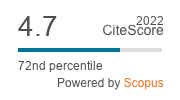Penicillium roqueforti produces mycotoxins including PR toxin, which is a food and feed contaminant. In this study, PR toxin was purified from culture material of the Penicillium roqueforti F43-1 strain. Toxic effects were evaluated in undifferentiated human Caco-2 intestinal epithelial cells and THP-1 monocytic immune cells. To understand the mechanisms involved in PR-toxin toxicity, cell death and pro-inflammatory gene expression were studied. In addition, PR toxin degradation was assessed. Cytotoxicity studies showed a dose-dependent effect of PR toxin and the calculated mean cytotoxic concentration (IC50) concentrations were for Caco-2 and THP-1 cells >12.5 and 0.83 μM, respectively. Gene expression studies showed that tumour necrosis factor-α expression was significantly increased after 24 h exposure to 312 μM PR toxin. PR toxin induced necrosis on THP-1 cells after 3 h exposure. In the cell culture system, the PR toxin showed a 10-fold reduction in PR toxin concentration within 48 h, indicating that PR toxin was degraded by THP-1. To conclude, PR toxin appears to be one of the most cytotoxic P. roqueforti mycotoxins on Caco-2 and/or THP-1 cells and induces in THP-1 cells both necrosis and an inflammatory response.
RESEARCH ARTICLE
Effect of PR toxin on THP1 and Caco-2 cells: an in vitro study
N. Hymery Related information
1Université de Brest, EA 3882, Laboratoire Universitaire de Biodiversité et Ecologie Microbienne, IBSAM, ESIAB, Technopôle Brest-Iroise, 29280 Plouzané, France.
*Corresponding author: nolwenn.
, O. Puel Related information*Corresponding author: nolwenn.
2Toxalim (Research Centre in Food Toxicology), Université de Toulouse, INRA, ENVT, INP-Purpan, UPS, Toulouse, France.
, S. Tadrist Related information2Toxalim (Research Centre in Food Toxicology), Université de Toulouse, INRA, ENVT, INP-Purpan, UPS, Toulouse, France.
, C. Canlet Related information2Toxalim (Research Centre in Food Toxicology), Université de Toulouse, INRA, ENVT, INP-Purpan, UPS, Toulouse, France.
3MetaToul-MetaboHUB, National Infrastructure of Metabolomics and Fluxomics, 31027 Toulouse Cedex, France.
, H. Le Scouarnec Related information3MetaToul-MetaboHUB, National Infrastructure of Metabolomics and Fluxomics, 31027 Toulouse Cedex, France.
1Université de Brest, EA 3882, Laboratoire Universitaire de Biodiversité et Ecologie Microbienne, IBSAM, ESIAB, Technopôle Brest-Iroise, 29280 Plouzané, France.
, E. Coton Related information1Université de Brest, EA 3882, Laboratoire Universitaire de Biodiversité et Ecologie Microbienne, IBSAM, ESIAB, Technopôle Brest-Iroise, 29280 Plouzané, France.
, M. Coton Related information1Université de Brest, EA 3882, Laboratoire Universitaire de Biodiversité et Ecologie Microbienne, IBSAM, ESIAB, Technopôle Brest-Iroise, 29280 Plouzané, France.
World Mycotoxin Journal: 10
(4)- Pages: 375 - 386
Published Online: November 16, 2017
2023 Journal Impact Factor
2.0
source: Journal Impact Factor 2023™ from Clarivate™

Institutional Offers
For institutional orders, please contact [email protected].
Purchase Options
-
P. Battilani and M. Camardo Leggieri
-
F. Xu, R.C. Baker, T.B. Whitaker, H. Luo, Y. Zhao, A. Stevenson, C.J. Boesch and G. Zhang
-
A.O. Aasa, F.F. Fru, O.A. Adelusi, S.A. Oyeyinka and P.B. Njobeh
-
R. Barkai-Golan and N. Paster
-
F. Wu
-
V. Ostry
-
R. Bandyopadhyay, A. Ortega-Beltran, A. Akande, C. Mutegi, J. Atehnkeng, L. Kaptoge, A.L. Senghor, B.N. Adhikari and P.J. Cotty
-
A. Logrieco, A. Moretti and M. Solfrizzo
-
G. Schatzmayr and E. Streit
-
B. Grenier and I. Oswald



